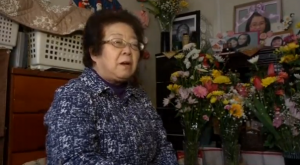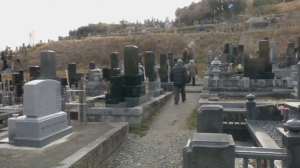
(Reuters) — Time has done little to heal the pain of Masako Sugawara, 70, who lost three of her grandchildren and her husband to the tsunami disaster in northern Japan five years ago.
When the magnitude-9.0 earthquake hit her hometown of Rikuzentakata in Iwate Prefecture, her husband Yoshikazu, then 68, rushed out to the nearby school to pick up 9-year-old Yue, 5-year-old Yui and 5-year-old Kazuki.
They were taking care of their children’s kids while they worked in the city.
Sugawara never saw the four again.
She said she felt helpless pain and guilt ever since.
“My daughter never blames me. She says, ‘It’s not your fault, mom.’ But it was my husband who picked them up, and that guilty feeling hurts me since that day,” Sugawara said.
She began knitting flowers and stuffed animals, things that her grandchildren loved. A volunteer who took care of her in an evacuation shelter taught her the skill.
“To me, this is a way of helping me distract myself,” said Sugawara with tears in her eyes.
For the last five years, she has knitted more than 500 items, which now decorate the flowery altar in her tiny room in a temporary house she’s been living in since July 2011.
“Believing that my grandchildren are looking down from the heavens, I started putting this stuff all over the room. That’s how it began,” Sugawara said.
Sugawara is one of the 3,040 people in Rikuzentakata who are still living in temporary houses, five years after the four-storey wave killed 7 percent of its 24,000 population and flattened the coastal town they used to call home.
A massive construction project has lifted the city centre above potential killer waves.
Excavators have scraped 7 million cubic metres of earth, the volume equivalent to 12 large sports stadiums, from a nearby mountain.
Cranes loom over a towering seawall as new roads snake over the hills and public housing estates can be seen farther off.
Sewage, water and electric grids must be laid by 2019, but building will start as early as this summer, offering hope for 1,400 households still living in temporary housing.
“When this project is completed, this city will become a place that will endure tsunamis. I hope people who fled their home come back again then,” one of the civil engineers at the site, Shimizu Construction’s Takahito Sakurai said.
However, some say the new embankments, roughly the height of the tsunami, are uncomfortable reminders of the tragedy. Even the landscape in which they were born and raised in has been transformed.
Mitsuko Oikawa, 78, who lost her house to tsunami and lived over two years in temporary housing, has decided to permanently immigrate to Morioka, an inland city 110 kilometers (66 miles) north from her hometown Rikuzentakata.
She was visiting the grave of her relatives who died in the tsunami.

“Five years hasn’t help much in the way we feel. I see the giant embankments next to where my house used to stand, and that feels strange. I cannot find a word to describe it. I just sigh,” she said.
A 9.0 magnitude earthquake struck northeast Japan in the afternoon of March 11, 2011, triggering tsunami waves as high as 30 metres (100 feet) that swept away residents and their homes.
Almost 19,000 people were killed and 315,000 were evacuated, including those who fled radiation from the devastated Fukushima atomic plant.








